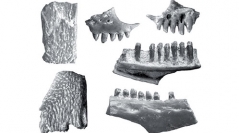

 Geodiversitas
30 (4) - Pages 731-763
Geodiversitas
30 (4) - Pages 731-763A new Miocene fauna of amphibians and squamate reptiles from Tauţ, Arad district, W Romania, is described. The Tauţ vertebrate locality is of early Sarmatian (late middle Miocene) age, biochronologically belonging to the European Mammal zone MN 7+8. The assemblage of marshy-lacustrine taphonomic context yielded one of the most diverse fauna of amphibians and squamate reptiles ever described from the late middle Miocene of Central and Eastern Europe. The taxonomic account includes at least four species of newts, six species of anurans, four species of lizards, one amphisbaenian and five species of snakes. The salamandrid Carpathotriton and the palaeobatrachid Palaeobatrachus cf. hiri, both with long aquatic phase, represent common taxa with those known from late middle Miocene of Mátraszőlős, N Hungary, indicating somewhat similar paleoecological conditions. Beside aquatic and periaquatic forms (some newts, Latonia, Palaeobatrachus, Pelophylax, Natrix), other taxa probably inhabited the surrounding terrestrial environments with azonal vegetation (Hyla cf. arborea) and areas covered with scrubs and forests (Geckonidae indet., Ophisaurus sp., Hierophis cf. hungaricus, Macrovipera sp.). Pelobates, Blanus cf. gracilis and Scolecophidia indet., were subterranean dwellers. A number of taxa (e.g., Triturus cf. marmoratus, Ophisaurus, Blanus cf. gracilis) indicate close palaeobiogeographic connections with the western Paratethys and Mediterranean areas. On the other hand, some snakes (e.g., Coronella, Hierophis cf. hungaricus and Macrovipera sp.) appear as Asiatic immigrants. The Tauţ herpetofauna differs from those of other coeval localities in the area by its abundance in water preferring amphibian groups, by presence of amphisbaenians and by lack of crocodiles as well.
Amphibia, Reptilia, Lacertilia, Serpentes, Amphisbaenia, Miocene, Romania